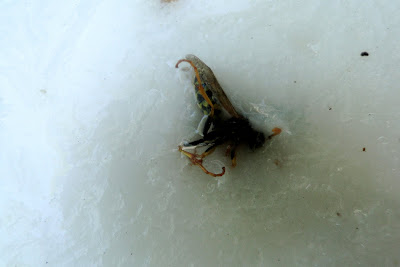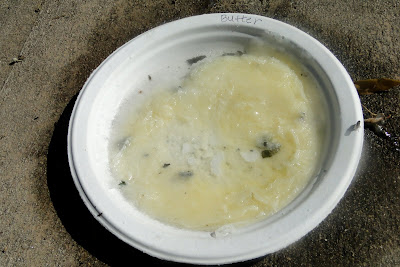I have gotten so many e-mails and comments about this, so I must say I’m a little nervous to report these results! I mean, they’re not bad or anything, but it’s not quite as exciting as we were all hoping… If you missed the introduction to this experiment, go HERE to read about it.


I began with the butter and margarine in the back yard. Mostly because I wanted to prevent the neighbors from thinking I’m crazy. There was little activity all morning, and since it was in the 90s that day, the butter and margarine started melting around noon. I figured this was okay – melted butter and margarine are still edible. In the early afternoon, I spotted this guy checking out the margarine. I had to photograph him through our back screen door, so I apologize for the fuzziness.


I’m guessing there were more squirrels involved in the feast, because when I went outside later that day to check on the plates, they were not quite as full.
I decided to leave them there overnight because there was still plenty left on the plates. This was probably a mistake, because around 5:00 am the sprinklers came on. Luckily oil and water don’t mix, so I didn’t lose any butter or margarine – I just had soggy plates. The butter/margarine was hardened on the bottom, and the water had pooled on top. That morning I drained the water off the top of the plates. A few hours later, there were ants all over the “butter water” on the sidewalk, but not much going on with the “margarine water”.



I was gone most of this day, but when I returned late that afternoon I noticed a lot of insects in the butter and not much going on with the margarine:



This guy must have been here for a while, because he eventually just got himself stuck as the butter started to harden towards the end of the day!

Finally, by the end of the second day, the butter was almost fully eaten and the margarine was only about half eaten. There were lots of insects stuck to the butter plate in various places, but only a few leaves and maybe one or two insects on the margarine plate.



Here’s what I learned from this experiment:
- Margarine is dark yellow when it melts, whereas butter is more of a pale yellow. This must have something to do with the preservatives and “fake” ingredients in the margarine being more difficult to break down.
- The animals tried both snacks, but the butter definitely got eaten more quickly. The margarine ingredients (listed HERE) included salt and buttermilk (among many other things), so there are still some “real” ingredients that tasted good to the animals.
- The margarine melted much more slowly than the butter (see photos at beginning of this post). This must be because of all of the fake ingredients that are added into the margarine.
- I’m really glad I used paper plates, or I would have had melted oil all over my sidewalk!

You can't really tell from the photo above, but the margarine was thick and most of it was leftover, whereas the butter plate only held a thin layer. I think I need to try this again in the fall, when it’s much cooler outside and the sticks of butter and margarine won’t melt. This will be a more accurate experiment, because I can do a better comparison of what’s leftover at the end of the day. SO, maybe I’ll try it again in few months – after all, I still have another stick of margarine in my fridge, and I won’t be using it for anything else!






















